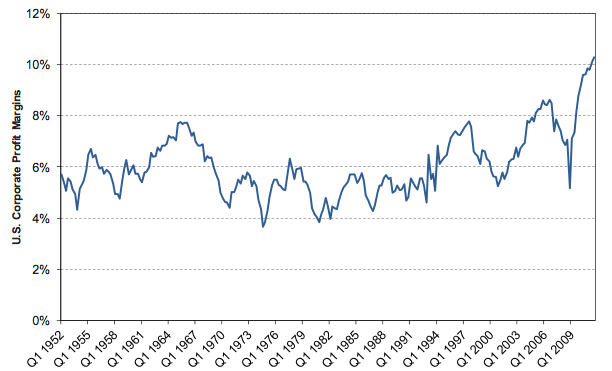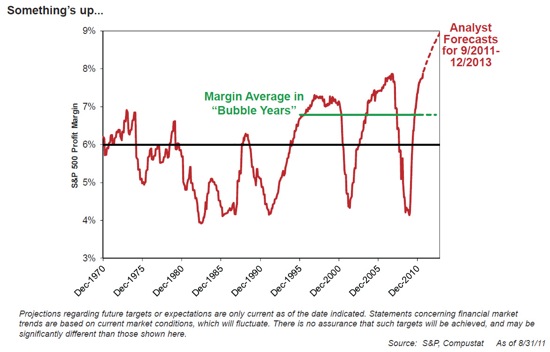James Montier of GMO (home of “doomster” Jeremy Grantham) published a fascinating note recently on profit margins, with a narrative around the well established concept of “reverting to the mean”. Two charts stood out, as Montier explained the macro drivers behind US corporate profits.
The first is the historical review of US corporate profit margins going back to 1952. For those unaware of the secular trends in US stock markets, the first uptick to 8% was the “nifty 50” bull market of the 1960’s, the flat lining down to 4% was the secular bear market of the 1970s (characterised by high inflation and stagnant stock prices).
The most recent, and seemingly unsustainable uptick back to 8% was the tech boom and Clinton era of the 1990’s, before reverting to the long run average but then reinflated by Greenspan et al, which terminated with the end of the Ponzi bubble market of 2003-2007:

Of course, the reversion back to the long running average couldn’t be allowed post-GFC, so cost of capital and other natural restraints on business – including high wages – were removed as part of monetary and fiscal policy in the US, which allowed an explosion in profit margin well above 10% of today.
Montiers main thesis is that the current trend on US corporate profits is unsustainable, and GMO uses the macro profits equation to explain:
Profits = Investment – Household Savings – Government Savings – Foreign Savings + Dividends
To us, the macro profits equation is a simple but powerful tool for understanding the drivers of profits, and helps us assess their sustainability. It is a useful organizing framework for thinking about the possibility of a structural break in profit margins. When we look at the drivers of today’s high profit margins, we find fiscal deficits behind the high profit margins of many countries. There is nothing “wrong” with this per se, but it does suggest that moves toward fiscal retrenchment will bring margins back toward more normal levels.
Of course, the US has been running a massive fiscal deficit since 2009, whilst US households have begun to deleverage there has been a small credit cycle (mainly due to the US education bubble) amongst this trend. Montier continues:
The government deficit may stay high this year, due largely to it being an election year. However, it is almost unthinkable that it will remain at current levels over the course of the next few years. As such, unless households start to re-leverage or the current account improves significantly, and assuming that the government moves toward some form of deficit reduction plan, corporate profits are likely to struggle. From this perspective, a structural break in profit margins looks to be difficult to support. So, for the time being we will continue to base our forecasts on the mean reversion of profit margins.
The 2nd chart shows the aggregate analysts forecasts for profit margin growth for FY12 and FY13, and even a casual observer – whilst cautiously optimistic of a US recovery – must ask themselves if this current trajectory is sustainable:
